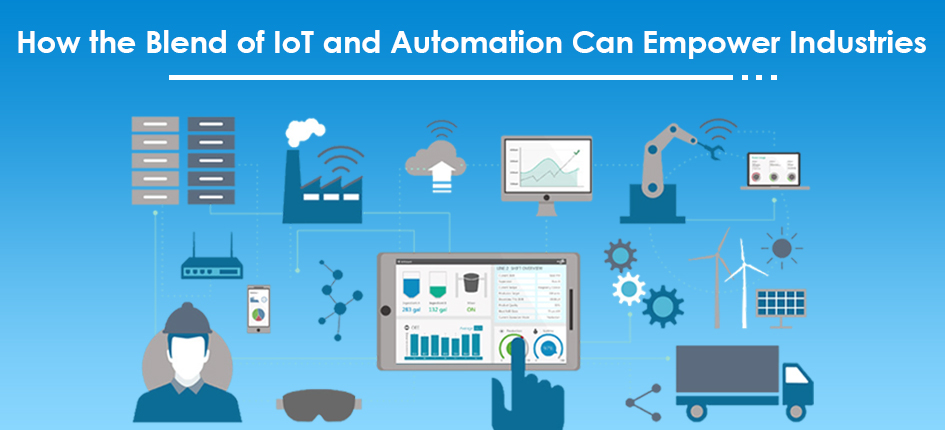How the Blend of IoT and Automation Can Empower Industries

IoT development is deemed a significant technological advancement in today’s industrial revolution. Businesses endeavoring to achieve better productivity and streamline internal operations are embracing this digital transformation.
Currently, most businesses strive to earn larger market shares but face challenges in creating innovative equipment and systems. IoT easily overcomes this hurdle by providing them high-speed and efficient systems that not only smoothly run their processes but also bring forth new revenue opportunities. Another challenge they encounter is the integration of these advanced systems for seamless apps. Original Equipment Manufacturers (OEMs) and design engineers employ research and development (R&D) strategy or avail IoT development services to build low-cost solutions aligning with the ever-changing demands as well as trends.
Impact of IoT on Automation
The IoT has reached the next stage of business, where the focal point is integration and convergence across industrial verticals. Businesses seem more focused on the value and objectives as compared to the versatility of connected devices now.
Besides, the advancements occurring in IoT connected devices, software, platform, apps, and systems are the key factors to take note of. They heavily rely on the implementation of subsystems and modular components that can boost efficiency and eventually reduce manufacturing costs. It is also imperative for manufacturers to develop equipment with flexibility in design, reusability, movement, and interconnectivity.
IoT-enhanced Manufacturing
With applications in home automation, healthcare, automobiles, and other industries, the Internet of Things has become ubiquitous. However, with conventional methods, manufacturers have to cope with a lot of obstacles while developing smooth communications for enhancing the capacity as well as flexibility of analyzers, actuators, and robotics. To overcome these challenges, IoT-enabled industrial automation offers the integration of multiple commercial technologies across significant industrial apps, such as Programming Logic Controllers (PLCs).
Additionally, managing the massive amount of data is also one of the biggest concerns of digitization. Analysis and distribution of garnered data are essential for OEMs to derive predictive models. These models help end-users to minimize costly unplanned downtime. Besides using the cloud, manufacturers need to create an interface to read the data as well as present relevant information to the end-user. Thus, automation engineers partner with IoT developers for efficiently managing data.
How IIoT is Transforming Manufacturing
Due to the increasing cost-effectiveness of cloud technologies, IoT, operations, and maintenance personnel are relying on IIoT by integrating more sensors, intelligent controls, and smart switches. Industries need systems that can perform predictive analysis and figure out the projected time of servicing. Researchers believe that such abilities have the potential of considerably reducing maintenance costs as well as breakdowns of companies.
Enterprises are having a keen interest in incorporating three crucial elements of business – machinery, robotics, and human power. So, manufacturers are embracing the advanced systems to minimize operational efforts as well as manufacturing costs.
Furthermore, elevating the adoption of supervisory control and data acquisition (SCADA) systems is a growth indication for traditional manufacturers. Conventional SCADA systems can’t communicate with logistics and operations. This is where IIoT comes into handy. Industrial IoT connects all aspects of manufacturing, including sales, operations, delivery, and inventory. These connections make equipment more autonomous, and above all, they can coexist with SCADA. Thus, it boosts integration and eventually replaces or incorporate data acquisition systems into IoT.
Four Key IoT Trends
According to Grand View Search, the global IIoT market is anticipated to reach approx. $933.62 by 2025. The need for real-time information remains the primary market propellant, and innovation is expected to drive IIoT demand. Most businesses focus on databases to monitor, categorize, and optimize operations. Emerging regions are also projected to witness significant growth with increased industrialization as well as the adoption of IoT over the coming years. Four major IIoT Trends are:
Data Intelligence
Continuously growing efforts to improve digital literacy is a significant trend anticipated to emerge in the coming future. Organizations invest in systems and programs to ensure the data collected is 100% accurate. Preferring data quality over quantity makes manufacturing companies ahead of the competitors. So, they are more likely to hire IoT development services to find a way to gauge the potential of major cloud platforms with the use of advanced tools.
Smart Cities
The rising demand for the connected environment, high precision location services, and autonomous technologies ensure the meteoric growth of IoT for smart cities. It not only boosts the adoption of IoT and IIoT but also improves infrastructure services and applications. Eventually, incorporation of these systems elevates the accuracy of parking systems, traffic lights, security systems, and more.
Business Collaborations
While innovations like flexible machines and systems and integration persist, businesses vigorously forge ahead. Most businesses engage in cooperative partnerships and business collaborations. Mergers and acquisitions (M&A) are expected to help businesses develop advanced capabilities and expedite their operations. Researchers suggest that M&A can bring analytics and digital capabilities under one roof and provide a competitive edge to the organizations.
Advanced Applications
The development of advanced apps, software upgrades, predictive maintenance, next-generation manufacturing, blockchain, and autonomous data centers also impact the manufacturing and automation engineering industries in the foreseeable years.
Final Words
Lack of data visibility and system upgrade costs used to be the biggest hindrance in most businesses until the advent of IoT. Also, data gathering and analysis is a time-consuming and attention-demanding task, which can disrupt routine operations. Incorporating IoT into industrial automation can resolve these problems and empower business verticals globally.
If you want to automate your processes by implementing IoT into your business, turn to our IoT development services. We will steer your whole IoT implementation journey right from ideation and consultation to development and deployment.

